Abstract
Background:
Patient satisfaction survey is a valuable tool to measure the outcomes of care rendered by hospitals. Outpatient department (OPD) is a very crucial area of any hospital services as huge number of patient's visits this area for clinical services. Information about quality of services in OPD will serve two purposes, i.e., identifying areas of improvement in the services offered and highlighting the need for corrective actions. Patient satisfaction is the key determinant for assessing the quality of patient care and is the desired outcome of every hospital. The present study was conducted to measure the levels of patient satisfaction and to ascertain any service gaps in OPD of a tertiary care teaching hospital, Mysuru, India.
Materials and Methods:
This cross-sectional, descriptive study was conducted among 600 patients using a structured questionnaire for assessing the levels of patient satisfaction.
Results:
The overall satisfaction rate in this study was 97.2%, with major satisfiers being clinical care provided by doctors and nursing staffs and few patients were not satisfied with cleanliness of toilets and medications' availability.
Conclusion:
Patient satisfaction survey may be a good audit tool and it should be used to improve the standard of services. According to the patient's opinion, the study showed good satisfaction with respect to reception and registration services, physical facilities, doctor's services, nursing services, laboratory services, and pharmacy services. Few deficient areas are identified in terms of service delivery and the same will be bridged as early as possible to achieve universal patient satisfaction.
Keywords: Hospital, outpatient department, patient satisfaction, quality
Résumé
Contexte:
L’enquête sur la satisfaction des patients est un outil précieux pour mesurer les résultats des soins rendus par les hôpitaux. Le service ambulatoire (OPD) est un domaine très crucial de tous les services hospitaliers car un grand nombre de visites de patients dans ce domaine pour des services cliniques. Les informations sur la qualité des services dans OPD serviront à deux fins, à savoir l’identification des domaines d’amélioration des services offerts et la mise en évidence de la nécessité de mesures correctives. La satisfaction des patients est le principal déterminant pour évaluer la qualité des soins aux patients et est le résultat souhaité pour chaque hôpital. La présente étude a été menée pour mesurer les niveaux de satisfaction des patients et pour déterminer les éventuelles lacunes de service dans le DPO d’un hôpital d’enseignement de soins tertiaires, Mysuru, Inde.
Matériel et méthodes:
Cette étude descriptive transversale a été menée auprès de 600 patients à l’aide d’un questionnaire structuré pour évaluer les niveaux de satisfaction des patients.
Résultats:
Le taux de satisfaction global de cette étude était de 97,2%, les principaux éléments de satisfaction étant les soins cliniques fournis par les médecins et le personnel infirmier et peu de patients n’étaient pas satisfaits de la propreté des toilettes et de la disponibilité des médicaments.
Conclusion:
L’enquête sur la satisfaction des patients peut être un bon outil d’audit et elle devrait être utilisée pour améliorer la qualité des services. De l’avis du patient, l’étude a montré une bonne satisfaction en ce qui concerne les services d’accueil et d’inscription, les installations physiques, les services médicaux, les services infirmiers, les services de laboratoire et les services de pharmacie. Peu de domaines déficients sont identifiés en termes de prestation de services et les mêmes seront comblés le plus tôt possible pour atteindre la satisfaction universelle des patients.
Mots clés: hôpital, service ambulatoire, satisfaction des patients, qualité
INTRODUCTION
Outpatient department (OPD) is defined as “segment or section of hospital with allotted physical facilities and medical and other staff in sufficient number, with regularly scheduled hours to deliver care for patients who aren't registered as inpatients.”[1] The outpatient service in an ambulatory care center, also called polyclinic, health center, walk-in-clinic, day hospital, dispensary, etc., serves as a part of the hospital or provide care standing free.
OPD in any hospital is considered to be the “Shop window” of the hospital.[2] Most of the time, OPD is the first point of contact between the hospital staff and the community.[3] Most of the patients nowadays can be diagnosed, treated, and even operated upon outpatient basis, thus involving less expenditure and efficient utilization of hospital beds for those genuine patients who need inpatient care.[4]
Patient satisfaction is one of the most important parameters of quality and is an indicator of how the patient has perceived qualitative aspects of care.[5] In the perspective of health care, patient satisfaction has been defined as a combination of experiences, expectations, and needs perceived and also as the patient's subjective evaluation of their cognitive and emotional reactions as a result of the interaction between their expectations regarding ideal care and their perceptions of the actual care.
Patient satisfaction depends on many factors such as quality of clinical services provided, attitude and behavior of doctors and other health-care staff, availability of prescribed medications, cost of the services, hospital infrastructure, physical comfort, emotional support, and respect for patient preferences.[6] Patient satisfaction regarding the attitude of providers is also expected to affect treatment outcome and prognosis.
The measurement of patient satisfaction is an important tool for research, administration, and planning and is the real testimony to the efficiency of hospital administration.[7] Patient is one who decides quality, who accepts services, who makes others to accept it, and who gives correct feedback about the performance of the hospital and makes the program of total quality management successful.[8]
It is now a global trend in health-care development toward integrating subjective user satisfaction into the evaluation of medical service quality.[9] Medical care aims not only to improve health status but also to respond to the patient needs and wishes and to ensure their satisfaction with care.[10] Patient satisfaction surveys are helpful in monitoring hospital's quality of care with various services offered and also serves as a significant quality indicator.[11] Keeping this in view, the present study was carried to assess the levels of patient's satisfaction toward OPD services at a tertiary care teaching hospital in Mysuru.
MATERIALS AND METHODS
The current study was conducted in the OPDs of general medicine, general surgery, orthopedics, and cardiology at a private university-based tertiary care teaching hospital in Mysuru, India. A cross-sectional study design was utilized to determine the levels of satisfaction experienced by patients.
A sample of 600 patients who received OPD services and agreed to participate in the study composed the study subjects. Inclusion criteria for the selection of subjects included patients whose age ranges are from 18 to 65 years old, who were willing to give verbal consent and who were able to listen and understand local language. Exclusion criteria included those who were unwilling to participate in the study, patients who had mental problems, and patients who need emergency attention.
A structured and pre-designed questionnaire was used to collect data and questionnaire was divided into three key parts: Part I included sociodemographic characteristics of the patients, i.e., gender, age, marital status, education, income status, and the source of meeting hospital expenses, part II comprised details of hospital visit in terms of duration, reasons, and time taken to reach the hospital, and the third part is about satisfaction of patients toward OPD services: -reception and registration, physical facilities, doctor patient interaction, nursing staff interaction, experiences with pharmacy services, experiences with laboratory services, overall services offered, and perception of waiting time at various services. The questionnaire consisted of 5-point Likert scale items like excellent, very good, good, fair, and poor. Patients/respondents indicated their level of satisfaction by selecting responses ranging from excellent to poor. Those selected excellent, very good, and good were considered satisfied and who chose fair and poor were considered dissatisfied. Patients were also asked if they had specific comments or suggestions regarding their encounter in the hospital.
Data were collected between November 2017 and November 2018. Questionnaires were given to patients who came to utilize our OPD after informed consent from each patient before data collection. Each patient took 10 to 15 min to be complete the questionnaire. The data collection was continued until the calculated sample size was achieved.
The study proposal was approved by the Institutional Ethical Committee of JSS Medical College with vide letter no. JSSMC/IEC/PG/4679/2016-17. Data were collected after official permission was granted from the hospital authorities. Nurse participated within the study were informed that participation within the study is voluntary, data collection was anonymous, and data were collected just for research purposes. Data were coded, entered into Microsoft Excel spreadsheet, and analyzed. The analysis was presented as descriptive statistics which included frequency and percentage.
RESULTS
A total of 600 patients attending the OPDs of general medicine, general surgery, orthopedics, and cardiology participated in this study. Maximum number of patients, i. e., 171 (28.5%), were in the age group of 18–30 years. About 53.8% of the patients were male. A majority of the respondents were younger than 50 years (70.5%) and were from rural areas (51.7%). Of 600 patients, 89.1% were Hindus, followed by 5.8% who were Christians. Demographic data consisting of marital status and socioeconomic status were also collected [Table 1].
Table 1.
Distribution of respondents according to the sociodemographic characteristics
| Sociodemographic factors | Number of respondents (n=600; 100%) |
|---|---|
| Gender | |
| Female | 277 (46.2) |
| Male | 323 (53.8) |
| Age (years) | |
| 18-30 | 171 (28.5) |
| 31-40 | 87 (14.5) |
| 41-50 | 165 (27.5) |
| 51-60 | 105 (17.5) |
| Above 60 | 72 (12) |
| Religion | |
| Hindu | 538 (89.7) |
| Muslim | 18 (3) |
| Christian | 35 (5.8) |
| Others | 9 (1.5) |
| Residence | |
| Rural | 310 (51.7) |
| Urban | 290 (48.3) |
| Marital status | |
| Single | 318 (53) |
| Married | 265 (44.2) |
| Widowed | 17 (2.8) |
| Level of education | |
| Postgraduate | 114 (19) |
| Undergraduate | 307 (51.2) |
| High secondary | 68 (11.3) |
| SSLC | 76 (12.7) |
| Primary | 26 (4.3) |
| Illiterate | 9 (1.5) |
| Source of income | |
| Government | 44 (7.3) |
| Private | 151 (25.2) |
| Business | 95 (15.8) |
| Agriculture | 49 (8.2) |
| Students | 142 (23.7) |
| Retired | 9 (1.5) |
| Not employed | 110 (18.3) |
| Income (Rs.) | |
| Below 2000 | 60 (10.0) |
| 2001-4000 | 50 (8.3) |
| 4001-6000 | 44 (7.3) |
| 6001-10000 | 157 (26.2) |
| Above 10,000 | 289 (48.2) |
| Hospital expenses | |
| Own | 549 (91.5) |
| Insurance | 9 (1.5) |
| Free | 25 (4.2) |
| Employee | 17 (2.8) |
About 51.2% of the study group were graduates, 24% were 10 + 2, 19% were postgraduates, 4.3% were educated up to primary level, while 1.5% were illiterates. On categorizing the patients by their occupation, 25.2% of the study subjects were employed in private sectors, 23.7% were students, 15.8% were self-employed, 8.2% were farmers, 18.3% were unemployed, and only 1.5% were retired.
Patients were also inquired about time taken to reach this hospital and type of visit whether it was first visit, follow-up visit, or referred from other hospitals. Majority of patients were nonreferral (39.3%) and had visited the hospital for the first time (36.7%) [Table 2]. In relation to referral pathways, the majority of respondents (39.3%,) came on their own, while 19.2% learned through their relatives/friends, 8.5% were referred by other hospitals, 20% visited due to hospital reputation and 13% visited, because the hospital was nearer to their residence.
Table 2.
Distribution of respondents according to the hospital visit
| Number of respondents (n=600; 100%) | |
|---|---|
| Visiting the hospital since | |
| For the first time | 220 (36.7) |
| 6 months to 1 years | 113 (18.8) |
| Since 1-3 years | 69 (11.5) |
| Since 3-5 years | 62 (10.3) |
| Over 5 years | 136 (22.7) |
| Reason for visiting this hospital | |
| Near to home | 78 (13) |
| Referred from another hospital | 51 (8.5) |
| Hospital reputation | 120 (20) |
| Referred by relatives/friends | 115 (19.2) |
| On own | 236 (39.3) |
| Time taken to reach this hospital | |
| <30 min | 242 (40.3) |
| 30 min-1 h | 183 (30.5) |
| 1-2 h | 113 (18.8) |
| >2 h | 62 (10.3) |
Figure 1 reveals that the overall satisfaction level of patients for reception and registration services in hospital OPD was good. As it was 96.9% for location and queue systems, 95% about staff courtesy and behavior, 95% information provided about their queries, 98.4% regarding space and counters provided for registration, and 92.6% for registration process in hospital, while 7.3% of the respondents had some kind of difficulty for registration process. About 4.5% of the patients replied that they were unsatisfied with behavior of registration staff.
Figure 1.
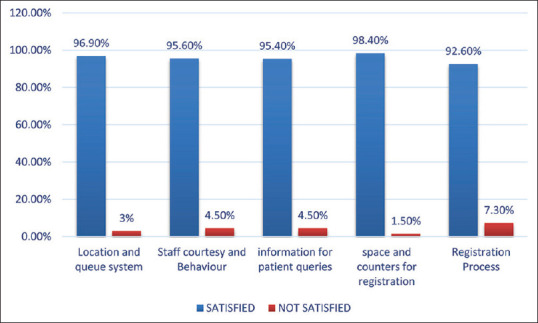
Satisfaction of respondents regarding reception and registration services
Patients' compliance in respect to clinical care [Figure 2] was more toward satisfactory side. Patient satisfaction rate was 97% for the clinical care provided by the doctor, explanation of the disease by the doctor and necessity of the investigation suggested, opportunity given to talk about their illness and listening skills of the doctor. As many as 98.5% of the patients replied that explanation about medications prescribed and doctor's courtesy and behavior was satisfactory. Almost 96% of the patients were satisfied with the instructions given for follow-up care. About 89.7% of the patients were fully satisfied with the time spent for consultation.
Figure 2.
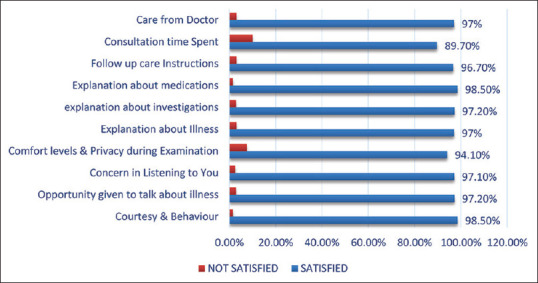
Satisfaction of respondents regarding doctor–patient relationship
About nursing services [Figure 3], 98.5% of the patients were satisfied with nursing staff's behavior and courtesy and only 1.5% were found unsatisfied. When asked about explanation/information given by nursing staffs for their queries, 95.6% of the patients were found satisfied and 4.5% were found unsatisfied.
Figure 3.

Satisfaction of respondents regarding nursing Staff
Maximum numbers of patients were satisfied regarding laboratory services [Figure 4], i.e., 89.8% for laboratory technician's behavior and courtesy, 88.3% for information provided about the procedure, 92.7% for cleanliness maintained inside the sample collection room, and 95.7% for present location and accessibility of sample collection area. With regard to information received about their report collection, 91.2% of the patients were satisfied and the remaining 7.5% showed their dissatisfaction.
Figure 4.
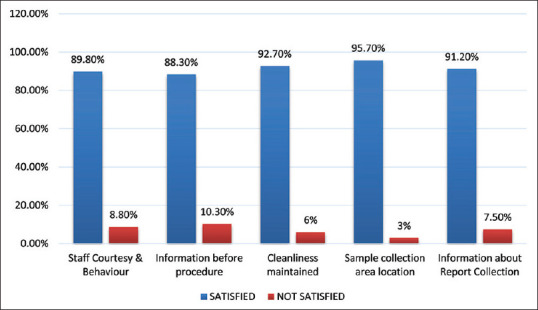
Satisfaction of respondents regarding laboratory services
As shown in Figure 5, regarding availability of prescribed medications, 84% of the patients were found satisfied and 16% were not. About explanation of treatment by pharmacist, 78% of the patients were satisfied and 22% were not satisfied. Almost 91% of the patients were satisfied with present pharmacy location. Figure 6 depicts that 97.2% of the respondents were satisfied with the overall services received from this hospital, while the remaining 2.8% were dissatisfied.
Figure 5.
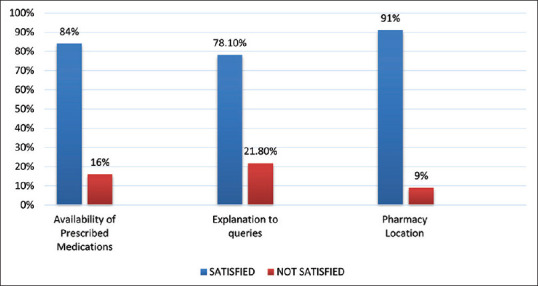
Satisfaction of respondents regarding pharmacy services
Figure 6.

Satisfaction of respondents regarding overall services offered at this hospital
Figure 7 shows that 33% of the patients had to wait <15 min before consulting doctor and for getting their medicines dispensed from the pharmacy. More than 15% of the patients waited for 15–20 min for registration, before consultation and near pharmacy for their medications. For about 19% of the patients waiting time at investigations was 20–25 min. Large number of patients, i.e., 88.3%, could get drugs within 30 min only.
Figure 7.
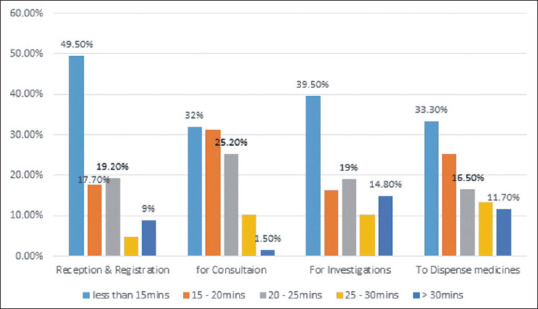
Distribution of responses of respondents regarding waiting time
Figure 8 shows that 95.5% of the respondents agreed that they will recommend this hospital to others and when asked about reuse of this hospital services, 89% of the patients agreed [Figure 9].
Figure 8.
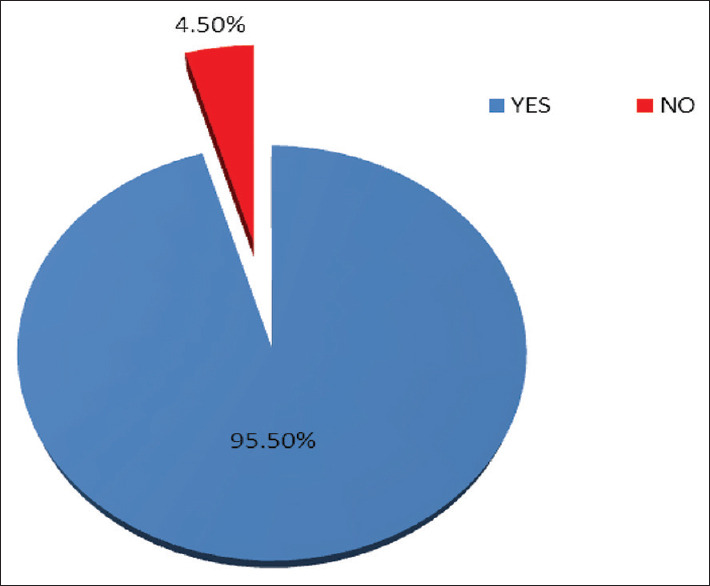
Distribution of responses of respondents regarding recommending this hospital to others
Figure 9.

Distribution of responses of respondents regarding availing of health-care services from this hospital in future
As shown in Figure 10 regarding drinking water facilities and cleanliness of the OPD waiting area, 91% of the patients were found satisfied and 9% were not. About adequacy of seating arrangement, 88% of the patients were satisfied. Regarding OPD attenders' helpfulness and courtesy and signages for accessibility, 92% of the patients were satisfied, while 8% were not. Near about 95% of the patients replied that they were satisfied with OPD working hours.
Figure 10.
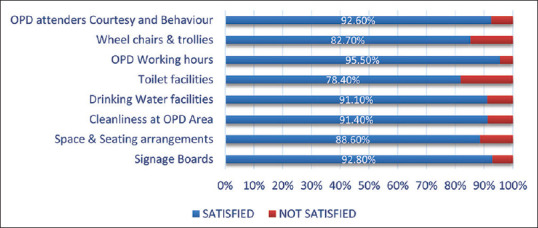
Distribution of responses of respondents regarding physical facilities
DISCUSSION
Assessing satisfaction of patients is simple and cost-effective way for evaluation of health-care services. However, it is challenging to measure the satisfaction and gauze responsiveness of the health-care systems as not only the clinical but also the nonclinical outcomes of care do influence the patient satisfaction.[12] The present study was an attempt to assess the levels of satisfaction of patients with OPD services. Strategies to enhance areas of dissatisfaction and sustain areas of high satisfaction should be implemented.
The patients intending to utilize the OPD services will have his or her first interface with the hospital at the OPD registration counters. The present study revealed that majority of the patients were satisfied with services provided during registration process like courtesy and behavior of the staff, waiting space, and information to their queries [Figure 1]. The results were consistent with the study done by Singh et al. in Punjab[13] and Syed Shuja Qadri in rural Haryana.[14] Only 1.5% of the respondents said that services were poor regarding the information provided to their queries and for the process of registration.
The present study revealed that more than 87% of the respondents were satisfied with the physical facilities of the hospital [Figure 10]. This included various aspects such as signages, cleanliness, drinking water, and toilet facilities. Rajbanshi et al. found that only 56.3% of the patients were satisfied with the physical facilities of the hospital.[15] Our study reveals that 91.4% of the patients satisfied with cleanliness maintained in the OPD. A similar study conducted in a hospital in Kerala showed that only 50% of the patients were highly satisfied with cleanliness of the OPDs.[16] In another study by Prasanna et al.[17] on consumer satisfaction about hospital services, a study from the OPD of a private medical college hospital at Mangalore, it was shown that patients were fully satisfied in respect to seating arrangement and cleanliness in the OPD and OPD timings, which was almost similar to the present study.
Doctor's behavior has the greatest effect on patient satisfaction.[18] Good communication between patients and clinicians has been described as the single most important component of good medical practice not only because it identifies problems quickly and clearly but it also defines expectation and help to establish trust between the clinician and patient.[19] In contrast, bad communication, particularly when the doctor appears indifferent, unsympathetic, or short of time make most patients dissatisfied.[20] The present study revealed that most of the patients were satisfied by the health-care services rendered by doctor [Figure 2]. About 98.5% of the patients were satisfied regarding doctor's behavior and courtesy. About 94.1% of the patients were satisfied with regards to privacy maintained by the doctor while examining. Almost 97% were satisfied viz-a-viz information given by a doctor to a patient. The results are higher than in the studies by Singh et al.[13] and Prasanna et al.[17] The high level of satisfaction with doctors in the present study may be attributed to the fact that majority of the respondents were government and private employees who were literates and hence more likely to have a better understanding of how the clinician is supposed to be and what he/she is supposed to do. About 89.7% of the respondents were satisfied with regard to the time spent by doctors during consultation. Good doctor–patient relationship is in itself therapeutic and successful consultation with a trusted and respected consultant will therefore have beneficial effects regardless of other therapy given.[20] This might be the single most important factor for the respondent's high level of satisfaction.
Quite a good number of the respondents were satisfied with the various components of nursing services like courtesy and behavior, explanation received for their queries. Only 1.5% of the respondents rated the behavior and courtesy of nursing staff as poor [Figure 3]. Most of the patients in the present study were satisfied with the laboratory services [Figure 4]. It was consistent with a study done by Singh et al.[13] and Prasanna et al.[17]
The availability of prescribed medications along with courteousness and communication skills of pharmacy staff has been key attributes toward patient's satisfaction in this area. The present study showed that pharmacy services were considered to be satisfactory viz a viz availability of prescribed drugs by 84% of the respondents [Figure 5]. This is consistent with a study done in rural Haryana[14] where patients are satisfied by the availability of essential medicines in the hospital. Taking into account regarding explanation from the pharmacy staffs for their queries, 21.8% shared dissatisfaction and this is an important area of concern.
The overall satisfaction of patients with services received from this tertiary care hospital came out to be 97.2% [Figure 6]. The satisfaction levels of patients are different in different studies. Jawahar SK in his study observed that 95% of the patients were satisfied with the services offered in the concerned hospital.[16] Kulkarni et al. in a study found that only 75% of the clients were satisfied with overall services available in hospital.[21] Many patient satisfaction studies have been carried out in India such as studies by Qadri et al. showing overall patient satisfaction of 79.3% in rural Haryana,[22] Deva et al. in Kashmir as 80%,[23] Kumari et al. in Lucknow reported as 81.6%,[24] Qureshi et al. in Kashmir as 72%,[25] and Bhattacharya et al.'s study as 88%.[26] In Africa, Ofili reported patient satisfaction of 83% in Benin City[27] and Iliyasu et al. reported 83% satisfaction in Kano, Nigeria. Similarly, a study in Ethiopia reported 77% of patient satisfaction in Jimma University Specialized Hospital.[28] These variations in different studies could be because of the use of different satisfaction instruments, variation in the ways services were delivered, differences in the study population, sociocultural differences and differences in levels of literacy, etc.
In this study, it was found that 49.5% of the patients were registered within 15 min, while 17.7% of the patients were registered within 15–20 min. Registration time may affected by factors such as number registration counters, day and time of visit to the hospital, etc., In this study, it was found that waiting time for registration was more than 30 min for only 9% of patients [Figure 7]. In a study conducted by Virmani et al., it was observed that 32% of the patients wait for approximately more than 20 min at the registration counter.[29] In the present study, it was noted that 32% of the patients waited up to 15 min, while 31.2% of the patients waited 15–20 min and 25.2% of patients waited for 20–25 min outside the various OPD's while seeking for medical care. In a study conducted by Virmani et al., it was found that 33% of the patients have to wait for more than 20 min and 14% patients have to wait for 15–20 min outside the consultation room and it was observed that the waiting time is more outside the medicine, surgery, and gynecology consultation rooms.[29] According to the standard operating procedures of OPD for district level hospitals, waiting time for collection of OPD ticket is 1 min, waiting time of 2–3 min for dispensing medicines, and time for laboratory investigation is 10 min.[30] In comparison to these standards, the findings of this study showed that it is rather longer. The present study showed that majority of the patients had to wait for less time, this could be due to better time management of working.
Some of the factors that attract patients to a health facility are availability of facilities, qualified personnel, and cleanliness of the hospital environment, etc., In the present study, it was seen that most of the patients, i.e., 95.5% [Figure 8], said that they would recommend this hospital to others, which is consistent with the results of other researchers like Singh et al.[13] and Kulkarni et al.[21] Such percentage of them recommending this hospital for others shows the higher level of satisfaction among the patients.
Despite the relevance and applicability of the information obtained in this study, our findings are likely to have some limitations. Information was obtained from the OPD patients who were available during the period of data collection only. First, the current study catered only outdoor patients. To evaluate the actual quality of services, it should have included indoor and emergency services also. Third, the findings emerging out of the current study cannot be generalized or extrapolated to all other hospitals of India, as the satisfaction levels of patients will be different in different studies. The responses of patients depend on their socioeconomic profile, personality, and their perceptions; some may be satisfied with average services, while others may be dissatisfied even with the best. In the present study, most of the respondents belonged to rural areas and middle or low socioeconomic class. Henceforth, it implies caution while comparing results from such a survey wherein the outcome may be largely associated with the sociodemographic profile of the study population.
In the modern era, it is the right of every patient to demand best possible care in hospitals and it is the duty of hospital staffs to deliver his/her optimum efforts to ensure satisfaction of the patient[31,32] and its assessment will give an opportunity to find loopholes in the services for future ratification.[33] It is also an internationally accepted factor which needs to be studied repeatedly for smooth functioning of the health-care systems.[34]
CONCLUSION
The study concludes that that the overall level of satisfaction with OPD services at this tertiary care hospital is high (97%) and encouraging, but there is always a scope for improvement. Major satisfiers were courtesy and behavior of doctors, explanation about medications (98.5% of respondents), explanation about disease and treatment by doctor's (97%), and behavior and courtesy of nursing staff (98.5%) at OPD's. Major dissatisfiers were cleanliness of toilets (17.3%), explanation from the pharmacy staff's (21.8%), nonavailability of prescribed medications (16%), and inadequate information given before the sample collection (10.3%).
Most of our patients want to reutilize our OPD services in future due to their good experience and high rate of satisfaction. The information obtained through this study is effective to get rid of discrepancies which are distorting the patient satisfaction so on make the hospital services more attractive for the patients. Therefore, it can be concluded that the OPD services form a crucial component of hospital services, and patient feedbacks are vital in improving the quality of health-care services in the OPD.
Recommendations
In view of observations made and to make the OPD services more efficient, the following recommendations are proposed:
Health educational talks can be arranged for patients in the waiting areas
Newspapers and health-related magazines should be provided in the sub-waiting area of OPD's
Cleanliness of toilets should be further improved so as to keep the patient satisfaction levels high
The drug policy should be revised quarterly and the prescribed drugs should be made available to keep the patient satisfaction levels high
Communication skills and behavior of the pharmacy staffs can be improved by conducting special sessions for behavioral change communication
Some patients are not satisfied with the information provided about their report collection. Hence, this study recommends that a signage board with approximate time after a particular test can be displayed in the sample collection areas
Although there are adequate numbers of wheelchairs, few patients expressed their dissatisfaction. Hence, it is suggested to provide more number of wheel chairs and better management of the same
A follow-up study is recommended among the health-care providers on challenges they are facing in meeting patient's expectations
Further satisfaction study should be extended in scope, such as a comparative study between patient satisfaction and staff satisfaction to gain better views and produce more meaningful results.
Financial support and sponsorship
Nil.
Conflicts of interest
There are no conflicts of interest.
Acknowledgments
We the authors would like to thank the institution for permitting to conduct this study.
We also would like to thank the staffs of departments of general medicine, general surgery, orthopedics, cardiology, community medicine, information technology, and nursing services who shared their experiences and information for the best output of results.
We the authors are also grateful to authors, editors, and publishers from where the literature for this article has been reviewed and discussed.
REFERENCES
- 1.Joshi DC, Joshi M. 1st ed. New Delhi: Jaypee Brothers Medical Publishers LTD; 2009. Outpatient department services. In: Hospital Administration; p. 209. [Google Scholar]
- 2.Gyani JG, Thomas A. 1st ed. New delhi: Jaypee Brothers Medical Publishers LTD; 1995. General medical services. In: Hospital Planning and Administration; p. 105. [Google Scholar]
- 3.Putsep E. London: Lloyd Luke Ltd; 1979. Modern Hospita; International Planning Practices. [Google Scholar]
- 4.Agarwal AK. New Delhi: School of Health Sciences; 2001. Clinical Services 1, Indira Gandhi National Open University. [Google Scholar]
- 5.Al-Abri R, Al-Balushi A. Patient satisfaction survey as a tool towards quality improvement. Oman Med J. 2014;29:3–7. doi: 10.5001/omj.2014.02. [DOI] [PMC free article] [PubMed] [Google Scholar]
- 6.Jenkinson C, Coulter A, Bruster S, Richards N, Chandola T. Patient's experiences and satisfaction with healthcare: Results of a questionnaire study of specific aspects of care. Qual Saf Health Care. 2002;11:335–9. doi: 10.1136/qhc.11.4.335. [DOI] [PMC free article] [PubMed] [Google Scholar]
- 7.World Health Organization. World Health Organization: 1984. Technical Report Services; p. 706. [Google Scholar]
- 8.Demir C, Celik Y. Determinants of patient satisfaction in a military teaching hospital. J Healthc Qual. 2002;24:30–4. doi: 10.1111/j.1945-1474.2002.tb00416.x. [DOI] [PubMed] [Google Scholar]
- 9.Tso IF, Ng SM, Chan CL. The development and validation of the Concise Outpatient Department User Satisfaction Scale. Int J Qual Health Care. 2006;18:275–80. doi: 10.1093/intqhc/mzl022. [DOI] [PubMed] [Google Scholar]
- 10.al-Mandhari AS, Hassan AA, Haran D. Association between perceived health status and satisfaction with quality of care: Evidence from users of primary health care in Oman. Fam Pract. 2004;21:519–27. doi: 10.1093/fampra/cmh508. [DOI] [PubMed] [Google Scholar]
- 11.Prakash B. Patient satisfaction. J Cutan Aesthet Surg. 2010;3:151–5. doi: 10.4103/0974-2077.74491. [DOI] [PMC free article] [PubMed] [Google Scholar]
- 12.Agarwal D. Health sector reforms: Relevance in India. Indian J Community Med. 2006;31:220–2. [Google Scholar]
- 13.Singh S, Kaur P, Rochwani R. Patient satisfaction levels in a tertiary care medical college hospital in Punjab, North India. Int J Res Develop Health. 2013;1:172–82. [Google Scholar]
- 14.Qadri SS, Pathak R, Singh M, Ahluwalia SK, Saina S, Garg PK. Patient satisfaction with services obtained from a tertiary care hospital in Rural Haryana. Int J Collab Res Int Med Public Health. 2012;4:1524–37. [Google Scholar]
- 15.Rajbanshi L, Dungana GP, Gurung YK, Koirala D. Satisfaction with health care services of outpatient department at Chitwan Medical College Teaching Hospital, Nepal. J Chitwan Med Coll. 2014;4:8–11. [Google Scholar]
- 16.Jawahar SK. A study on out patient satisfaction at a super specialty hospital in India. Int J Med Update. 2007;2:13–7. [Google Scholar]
- 17.Prasanna K, Bashith M, Sucharitha S. Consumer satisfaction about hospital services: A study from the outpatient department of a private medical college hospital at Mangalore. Indian J Community Med. 2009;34:156–9. doi: 10.4103/0970-0218.51220. [DOI] [PMC free article] [PubMed] [Google Scholar]
- 18.Rao KD, Peters DH, Bandeen-Roche K. Towards patient-centered health services in India-a scale to measure patient perceptions of quality. Int J Qual Health Care. 2006;18:414–21. doi: 10.1093/intqhc/mzl049. [DOI] [PubMed] [Google Scholar]
- 19.Reeder LG. The patient-client as a consumer: Some observations on the changing professional-client relationship. J Health Soc Behav. 1972;13:406–12. [PubMed] [Google Scholar]
- 20.Bush T, Cherkin D, Barlow W. The impact of physician attitudes on patient satisfaction with care for low back pain. Arch Fam Med. 1993;2:301–5. doi: 10.1001/archfami.2.3.301. [DOI] [PubMed] [Google Scholar]
- 21.Kulkarni MV, Dasgupta S, Deoke AR, Nayse Study of satisfaction of patients admitted in a tertiary care hospital in Nagpur. Natl J Community Med. 2011;2:37–9. [Google Scholar]
- 22.Qadri SS, Pathak R, Singh M, Ahluwalia SK, Saina S, Garg PK. Patient satisfaction with services obtained from a tertiary care hospital in RuralHaryana. Int J Collab Res Int Med Public Health. 2012;4:1524–37. [Google Scholar]
- 23.Deva SA, Haamid M, Naqishbandi JI, Kadri SM, Khalid S, Thakur N. Patient satisfaction survey in outpatient department of a tertiary care institute. J Community Med. 2010;6:328–34. [Google Scholar]
- 24.Kumari R, Idris M, Bhushan V, Khanna A, Agarwal M, Singh S. Study on patient satisfaction in the government allopathic health facilities of lucknow district, India. Indian J Community Med. 2009;34:35–42. doi: 10.4103/0970-0218.45372. [DOI] [PMC free article] [PubMed] [Google Scholar]
- 25.Qureshi W, Naikoo GM, Baba AA, Jan F, Wani NA, Hassan G, et al. Patient Satisfaction at Tertiary Care Hospitals in Kashmir: A Study from the Lala Ded Hospital Kashmir, India. Internet J Health. 2009;82:1–2. [Google Scholar]
- 26.Bhattacharya A, Menon P, Koushal V, Rao KL. Study of patient satisfaction in a tertiary referral hospital. J Academy Hospital Administrat. 2003;15:11–5. [Google Scholar]
- 27.Ofili AN, Oforwe CE. Patients' assessment of effi ciency services at a teaching hospital in a developing country. Ann Afr Med. 2005;4:150–3. [Google Scholar]
- 28.Iliyasu Z, Abubakar IS, Abubakar S, Lawan UM, Gajida AU. Patient's satisfaction with services obtained from Aminu Kano Teaching Hospital, Northern Nigeria. Nigerian J Clin Practice. 2010;13:371–8. [PubMed] [Google Scholar]
- 29.Virmani V, Bansal AK, Pandit DP, Howale DS. Waiting time analysis at outpatient department at GMERS Medical College Hospital, Valsad. Int J Sci Res. 2014;3:280–2. [Google Scholar]
- 30.Director General of Health Service. Standards for District Hospitals. Development of Health Care Quality Assurance Project. 1997:9–15. [Google Scholar]
- 31.Nasir F, Herani G, Nawaz A. Identifying factors affecting patient's satisfaction against quality of health care services: An investigation from Aga Khan Hospital Karachi. KASBIT Bus J. 2012;17:62–8. [Google Scholar]
- 32.Llego JH, Al Shirah MO. Patient satisfaction in tertiary private hospitals in Najran, Kingdom of Saudi Arabia. Int J Res Foundat Hospital Health Care Administ. 2017;5:42–6. [Google Scholar]
- 33.Virk A, Kalia M, Gupta BP, Singh J. A study to evaluate patient expectation and satisfaction in a Tertiary Care Teaching Hospital. Healthline. 2013;4:64–8. [Google Scholar]
- 34.White B. Measuring Patient Satisfaction: How to do it and why to Bother Family Practice Management. 1999. [Last accessed on 2018 Sep 20]. Available from: http://www.aafp.org/fpm/990100fm/40.html . [PubMed]


